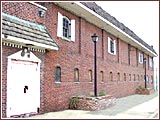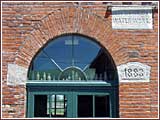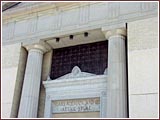A GRIMIER VIEW OF HISTORY
Industrial Historian Honored for National Register Work
July 16, 2001
By Hoag Levins
CAMDEN, N.J. -- While many prefer to see Delaware Valley history as a Williamsburg-like domestic tableau of open-hearth cooking, hand-spun wool and docents in tricorner hats, Paul W. Schopp takes a somewhat grimier view of our ancestors' daily world.

|
| Photo: Hoag Levins. |
|
Paul W. Schopp, a historian fascinated with the engineering side of life.
|
|
The former executive director of the Camden County Historical Society (CCHS) gazes across the same territory and sees a vanished landscape of screaming steam valves and dusty work sheds, soot-smudged smoke stacks and metal-stamping machines, trolley cars and brass cash registers. To Schopp, history is about business and engineering infrastructure.
"It's very difficult to explain history without including the industry that was involved in it," said the 48 year old, who is now staff historian at A.D. Marble & Co., an environmental engineering and cultural resource management firm in Rosemont, Pa.
The books and papers he has authored include such titles as Trail of the Blue Comet: A History of the Jersey Central's Southern Division, New Jersey Linseed Oil Mills, Nickel Processing in New Jersey
from Camden to Constable Hook, and Eavenson & Levering, Wool Scourers.
"I've always been fascinated with industrial processes and transportation systems," said Schopp, a member of the national Society for Industrial Archeology. "If you look at the National Register nominations I've done -- the Volney Bennett Lumber Co., Gloucester City Water Works and the Sears Building -- they are all buildings that were either industrial or commercial sites."
National Register
Established by the National Historic Preservation Act of 1966, the National Register of Historic Places is maintained by the U.S. Interior Department as the nation's "official list of American cultural resources worthy of preservation." In order to be accepted onto the list, a site must go through an arduous evaluation and approval process.
The nomination -- an in-depth history, architectural description and assessment of cultural significance presented to a review board -- is the pivot on which a National Register application turns. Despite repeated attempts, many historians across the country never succeed with any of their nominations.
Schopp, on the other hand, has prepared the crucial documents resulting in three Camden County sites being approved for inclusion in the National Register.
Appointed Society Historian
Schopp has just been appointed the first official historian the 101-year-old Camden County Historical Society has ever had, in part because of his National Register successes.
"Paul's understanding of the industrial matrix that underlies virtually all the history of this area is as extraordinary as his ability to get three local industrial sites into the National Register," said CCHS president David Munn. "His in-depth knowledge of this specialized field is a major asset to the people of Camden County as well as the Society, and this appointment is designed to publicly recognize that."
Schopp, who has twice been appointed by the Governor of New Jersey to sit on the state Historic Records Advisory Board, admits that a large part of the public doesn't really think about old factories and work yards as historic sites. But, he suggests, people have only to look as far as their own neighborhoods to understand the true importance of yesteryear's industries to their families and society as a whole.
Industry shapes history
"Take a city like Camden," he said. "You can not separate its history from its industrialization because it was the industry that caused the city to grow the way it did. Look at Fairview, once known as Yorkship Village when it was constructed for New York Shipbuilding workers. Or Morgan Village, originally constructed for people who worked either at New York Ship or Camden Forge. These neighborhoods were shaped by the industries that gave rise to them. You can't really hope to understand the residents' daily physical reality or sense of self without understanding the industrial activities that were the center of their community experience.
These are the three sites that Schopp has helped to get into the National Register:
Volney Bennett Lumber Co.
In the decades prior to the Civil War, in an age when wood was the primary component

|
| Photo: Hoag Levins. |
|
The former Volney Bennett building at Second and Spruce Streets in Camden looks like this today. It once housed 20 teams of horses.
See more photos.
|
|
for making everything from houses and factories to wagons and sailing ships, lumber milling was the largest industry in Camden, Schopp explained. Entire swaths of the city's waterfront were devoted to receiving and storing the rafts of timber felled in Pennsylvania and towed along the Delaware to Camden.
In 1859 Volney G. Bennett reportedly floated into town on one of those log rafts, took a job at a lumber mill and eventually ended up running his own waterfront mill at Second and Spruce Streets, Schopp said. By the late 1800s the Volney G. Bennett lumberyard sprawled across an entire city block and was the largest retail operation of its kind in the state.
In-house stables were an integral part of the business which used teams of four horses each to pull a fleet of lumber delivery wagons. The first floor of the huge stable building ultimately housed 20 teams of horses; the second floor was a storage area for hay and harness gear.
In 1911 a client company that was out of cash offered to pay its outstanding Volney Bennett lumber bill in motor trucks.
"That revolutionized the business," said Schopp. "Bennett Lumber was soon using motor trucks to make deliveries all over south Jersey. It supplied much of the lumber for the Atlantic City boardwalk. Then it began to rent the stable building out and eventually that came full circle as what was once a stable became a showroom for the business."
"The interesting thing about that Register nomination," he continued, "is not only did we nominate the stable building, we nominated the entire city block that contained lumber sheds that are now all gone. I thought it was interesting that they accepted an empty city block into the National Register."
Gloucester Water Works
Although few think of history when they turn their kitchen faucet handles, that dependable flow of potable water is a vital

|
| Photo: Hoag Levins. |
|
The Gloucester City Water Works Building has the look of a fortress.
See more photos.
|
|
fluid of modern civilization. Without it, cities could not exist; the history of the heroic engineering efforts to provide it dates to 1797. Then, the country's largest city -- Philadelphia -- completed the first waterworks astride the Schuylkill River. Now sitting in the shadow of the Philadelphia Art Museum, the two-century-old Gothic, Greek and Roman Revival structures of that original American waterworks are a National Historic Landmark.
But that was only the beginning of the story. By the latter 1800s, as the density of their populations -- and backyard privies -- made well water increasingly unsafe, smaller municipalities were forced to undertake their own efforts to invent and maintain central, secure potable water systems. At the time, such projects were the most expensive and most complicated ever faced by local governments. The 1883 Gloucester City Water Works building on Johnson Boulevard and the banks of Newton Creek is a monument to that era of engineering innovation.
"When the review board first looked at the photos, they thought the Gloucester Water Works was just another ho-hum building," said Schopp. "But I crafted that nomination in such a way that I started with the use of pipes in Rome and Greece to supply fresh water and moved up through the ages until I arrived at Gloucester Water Works. When the board members read it, they could understand the national importance of this building. They voted for it unanimously."
Sears Building
When it comes to the evolution of mass merchandising over the last century, few stand as tall as Sears, Roebuck & Co.

|
| Photo: Hoag Levins. |
|
Built to resemble an acient Greek temple, the Sears building has been a local landmark for 74 years.
|
|
Begun in 1886 as a merchant of gold-plated watches to railway workers, the Chicago firm created by Richard Sears and Alvah C. Roebuck issued its first catalog in 1895. Offering everything from stoves and saddles to rocking chairs and petticoats, the company offered rural residents mail-order access to products they could not find at their local general stores.
In 1925 Sears began constructing its first retail outlets across the country. By 1927, 27 Sears department stores were open -- the most architecturally stunning of which was the Greek Revival building erected on the main road connecting Camden's new Delaware River bridge to a crescent of suburban developments sprouting east of the city.
That retail operation at what is now 1300 Admiral Wilson Boulevard helped define the very concept of "department store." It was a Sears & Roebuck until 1971, when the company moved its retail store to the Moorestown Mall, leaving behind a landmark of grand columns and ornately carved stone.
"Not only is the Sears & Roebuck building a temple of commerce featuring magnificent architecture," said Schopp, "it is also significant for Camden City and Camden County because it was built along the bridge boulevard, making it easily accessible by automobile. They were the first store in Camden to offer a 600-car parking lot. For the first time, a large retail operation was readily accessible by those who were moving to the suburbs. For that reason, the Sears store actually fostered the decline of downtown Camden."
| 






